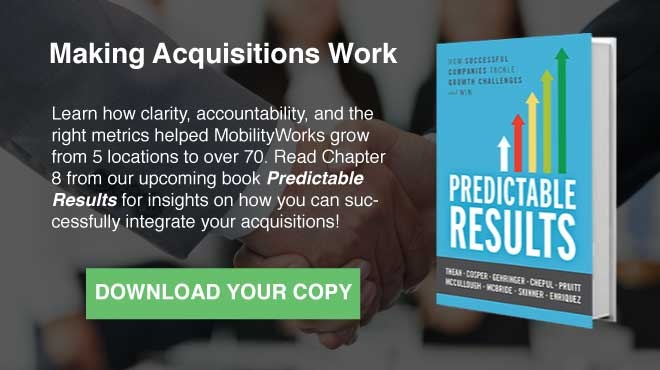Mergers and Acquisitions (M&A) are not for the faint of heart. Any CEO who has navigated those waters will tell you it is a tremendous challenge to blend cultures, systems, processes and teams successfully. The statistic is 70-90% of M&A's fail -- that's a scary number! Instead of focusing on that metric, let's talk about numbers we should be measuring around M&A.
you it is a tremendous challenge to blend cultures, systems, processes and teams successfully. The statistic is 70-90% of M&A's fail -- that's a scary number! Instead of focusing on that metric, let's talk about numbers we should be measuring around M&A.
Every acquisition deal starts with an incredible amount of due diligence. Are the cultures and values compatible? Do the product lines and customer bases support each other? Do the numbers work and take us down a path of growth? Ultimately, if the deal goes through, benefits have been seen by both parties. Now, it's up to the newly-merged company to both preserve the current value of the organization and meet growth projections. It's a delicate balance.
For a CEO to have clear visibility of a company's overall health, KPIs should exist in the following four scorecard categories: Customers, Employees, Processes and Revenue. If all four areas of the organization are healthy, that's a great indicator of a successful M&A. Each of the four categories should have a balance of metrics that measure current state (maintenance of value) and future state (growth projected during due diligence).
 Here are some examples in each category:
Here are some examples in each category:
Employee KPIs
- Employee Retention of A players: Inevitably, M&A will produce some redundancies that need to be worked out. After all, you can't have two CFOs. The important thing to measure is that you are keeping the people you want to keep. If all of your A players are quitting, you know you need to make some adjustments on the culture front.
- Employee Health Index: In many cases, M&A can cause stress on certain departments. For example, is your support department now supporting twice the customers with the same amount of people? Measure employee health to highlight potential burnout. Are people working lots of overtime or not taking their vacation days? Make those factors part of an Employee Health Index.
- Employee NPS (Net Promoter Score): When the dust settles, is your new company still a place your employees would recommend to their friends and family for employment? Use a simple NPS survey to gauge employee happiness & engagement and make sure it grows over time.
Customer KPIs
- Customer Retention: Following the M&A, are you retaining clients at the same rate as before? Was there a mass exodus of clients from either company's customer base? Use historical retention rates from both companies and establish an acceptable level of client retention for the new company. What would you consider failure?
- Customer Health Index: In this case, customer health is a leading indicator of retention. After all, customers who have unresolved support issues or who are dragging their feet on renewing a contract are those who have the potential to leave you. Have any of your Top 20 customers stopped being responsive to their account manager or stopped paying their bills? Make those factors part of your Customer Health Index.
- Customer NPS: Post M&A, are your Customers still referring you? Similar to the Employee NPS, use a simple survey to gauge customer happiness and make sure it grows over time.
Processes KPIs
- System Conversion/Adoption: Systems are another area for redundancy after M&A. For example, if both companies didn't use the same accounting system before, they'll need to decide which one they are going to use and convert users. This can be a laborious process for all involved. It can impact productivity, employee health and even your cash flow. Measure system conversion and adoption rates to set clear expectations on when new systems should be up and running and by when.
- Actual v. Budget: Following due diligence and budgeting, everyone should have a clear picture of where they projected the new company to be on expenses, margins, profit, etc. Measure this closely and make adjustments quickly if your projections were off. M&A is filled with unknowns, especially in the area of expenses.
- Productivity/Efficiency: Productivity and efficiency measurements speak to the culture, systems and processes. Measuring productivity is a great gauge to tell if these areas are working well. If there is a breakdown in any of these, you will see it in your productivity.
Revenue KPIs
- Sales/Revenue: Each company brought with it an anticipated book of business. This KPI is about making sure you preserve that asset. If you don't lose any big clients and your sales engine remains predictable and consistent, you'll retain that value. Make sure to keep a close eye on this and make adjustments if anything happens to take revenue off track.
- Expected Growth/Expansion: Most M&A's make sense because the two companies have complementary products or customer bases. For example, if you projected that 50% of Company A's customers would buy Company B's product, you should measure that. If the deal was made with a specific expectation of growth in mind, put some real metrics to it.
- Profit/Margin: This one can be tricky. Sometimes, depending on the deal, there is an anticipated flatness or even loss in profit/margin at the beginning. For example, you might be expecting heavier carrying costs for the first two quarters, but after liquidating redundant assets you anticipate becoming profitable again. Know that going into it and measure it accordingly. If you don't see this metric move to profitability when you expected to see it, you know an adjustment is necessary.
The first step to fixing something is to measure it. Acquisition KPIs can be difficult to install but with these four key areas covered, you would be well on your way to being in the 10-30% of successful M&A companies!
Read our other content to help make acquisitions work
Culture is Key to Breakthrough Execution with Mergers and Acquisitions
The Right KPIs to Prevent M&A Failure - Rhythm Systems
How to Acquire a Business Without the Drama
5 Steps to Integrate Your Culture After a Business Acquisition
3 Ways Top Middle Market Executives Make the Most of M&A
5 Integration Mistakes that Could Sink Your Business Acquisition
4 Ways to Prepare Your Employees for a Merger
Photo Credit: iStock by Getty Images
Photo Credit: iStock by Getty Images



 LinkedIn
LinkedIn
 Facebook
Facebook
